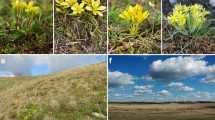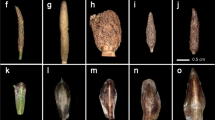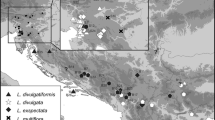Abstract
In order to provide insight into the possible differentiation withinMyosotis lamottiana, which is a classical example of a species with a disjunct distribution area, a morphological analysis of 12 populations and a chromosome number analysis of 15 populations were made. Conspicuous chromosomal differentiation was observed comprising diploids (2n=22) and tetraploids (2n=44). The diploid chromosome number is reported for the first time for this species. Diploid and tetraploid cytotypes differ in geographical distributions; diploids are restricted to the Massif Central and tetraploids to the Pyrenees, Mt. Picos de Europa and the Cantabrian Mountains. A detailed morphometric analysis, however, revealed no clear-cut differences in the morphology of diploids and tetraploids except for pollen size, which is a character obviously correlated with ploidy level. No obvious ecological differences were observed between the cytotypes. It was concluded that the current disjunct distribution of diploids and tetraploids ofM. lamottiana may be explained by non-adaptive processes rather than by adaptive ones. A morphological description and notes on the nomenclature ofM. lamottiana are presented as well. A lectotype is chosen and designated for the nameMyosotis lamottiana Braun-Blanq.
Similar content being viewed by others
References
Beaulieu J.L. de, Clerc J. &Reille M. (1984): Late Weichsellian fluctuations in the French Alps and Massif Central from pollen analyses. In:Mörner N.-A. &Karlén W. (eds.),Climatic changes on a yearly to millennial basis, D. Reidel Publishing Company, Dordrecht, pp. 75–90.
Blaise S. (1975): 335.Myosotis L. In:Guinochet M. &de Vilmorin R. (eds.),Flora de France, Centre National de la Récherche Scientifique, Paris, pp. 591–601.
Blaise S. (1981): [Report]. In:Löve A. (ed.), IOPB Chromosome number reports LXX,Taxon 30: 76.
Braun-Blanquet J. (1923):L’origine et le développement des flores dans le Massif Central de France avec aperçu sur les migrations des flores dans l’Europe sud-occidentale. Léon Lhomme, Paris, Beer & Cie, Zürich.
Braun-Blanquet J. (1926a): Le climax complexe des landes alpines (Genisteto-Vaccinion du Cantal). In:Braun-Blanquet J. (ed.),Études phytosociologiques en Auvergne, G. Mont-Louis, Clermont-Ferrand, pp. 29–48.
Braun-Blanquet J. (ed.) (1926b):Études phytosociologiques en Auvergne. G. Mont-Louis, Clermont-Ferrand.
Brochmann Ch. &Elven R. (1992): Ecological and genetic consequences of polyploidy in arcticDraba (Brassicaceae).Evol. Trends Pl. 6: 111–124.
Chassagne M. (1957):Inventaire analytique de la flore d’Auvergne et contrées limitrophes des départements voisins 2. Lechevalier, Paris.
den Nijs J.C.M. (1974): Biosystematic studies of theRumex acetosella complex. I. Angiocarpy and chromosome numbers in France.Acta Bot. Neerl. 23: 655–675.
den Nijs J.C.M. (1976): Biosystematic studies of theRumex acetosella-complex. II. The alpine region.Acta Bot. Neerl. 25: 417–447.
den Nijs J.C.M. (1983): Biosystematic studies of theRumex acetosella complex (Polygonaceae). VI. South-eastern Europe, including a phylogenetic survey.Bot. Jahrb. Syst. 104: 33–90.
den Nijs J.C.M. (1985): Biosystematic studies of theRumex acetosella complex. IX. Cytogeography of the complex in the Iberian Peninsula and taxonomic discussion.Bot. Helv. 95: 141–156.
Ehrendorfer F. (1949): Zur Phylogenie der GattungGalium I. Polyploidie und geographisch-ökologische Einheiten in der Gruppe desGalium pumilumMurray (Sekt.LeptogaliumLange sensuRouy) im österreichischen Alpenraum.Österr. Bot. Z. 96: 106–138.
Ehrendorfer F. (1962): Cytotaxonomische Beiträge zur Genese der mitteleuropäischen Flora und Vegetation.Ber. Deutsch. Bot. Ges. 75:137–152.
Ehrendorfer F. (1980): Polyploidy and distribution. In:Lewis W.H. (ed.),Polyploidy, biological relevance, Plenum, New York, pp. 45–60.
Favarger C. (1984): Cytogeography and biosystematics. In:Grant W.F. (ed.),Plant biosystematics, Academic Press, Toronto etc., pp. 453–476.
Felber F. (1991): Establishment of a tetraploid cytotype in a diploid populations: Effect of relative fitness of the cytotypes.J. Evol. Biol. 4:195–207.
Felber-Girard M., Felber F. &Buttler A. (1996): Habitat differentiation in a narrow hybrid zone between diploid and tetraploidAnthoxanthum alpinum.New. Phytol. 133: 531–540.
Fournier P. (1977):Les Quatre Flores de la France. Editors Lechevalier S.A.R.L., Paris.
Grau J (1964): Zytotaxonomie derMyosotis alpestris- und derMyosotis sylvatica Gruppe in Europa.Österr. Bot. Z. 11: 516–617.
Grau J. (1970): Cytotaxonomische Bearbeitung der GattungMyosotis L. IV. Ergänzenden Studien.Mitt. Bot. Staatssamml. tMünchen 8: 127–136.
Grau J. &Merxmüller H. (1972): 29.Myosotis L. In:Tutin T.G. et al. (eds.),Flora europaea 3, Cambridge University Press, Cambridge, pp. 111–117.
Greuter et al. (2000): International code of botanical nomenclature (Saint Louis Code).Regnum Veg. 138.
Hagerup O. (1932): Über Polyploidie in Beziehung zu Klima, Ökologie und Phylogenie.Hereditas 16: 19–40.
Krahulcová A. &Štěpánková J. (1998): Serpentine and polyploid differentiation withinGalium pumilum agg. (Rubiaceae) in Eastern C. Europe.Folia Geobot. 33: 87–102.
Krendl F. (1993): Chromosomenzahlen und geographische Verbreitung in der GattungGalium (Sect.Leptogalium — Rubiaceae).Biosyst. Ecol. Ser. 4: 51–112.
Küpfer Ph. (1974): Recherches sur les liens de parenté entre la flore orophile des Alpes et celle des Pyrénées.Boissiera 23: 1–322.
Küpfer Ph. (1980): Les processus de différenciation des taxons orophiles en Méditerranée occidentale. Acta III. Congr. Optima.Anales Jard. Bot. Madrid 37: 321–337.
Lamotte M. (1877):Prodrome de la Flore du Plateau central de la France. Masson, Paris.
Lecoq H. &Lamotte M. (1847):Catalogue raisonni des plantes vasculaires du Plateau central de la France, comprenant l’Auvergne, le Valay, la Lozhere, les Civennes, une partie du Bo. Masson, Paris.
Levin D.A. (1975): Minority cytotype exclusion in local plant populations.Taxon 24: 35–43.
Levin D.A. (1983): Polyploidy and novelty in flowering plants.Amer. Naturalist 122: 1–25.
Lewis W.H. (1967): Cytocatalytic evolution in plants.Bot. Rev. 33: 105–115.
Lewis W.H. (1980): Polyploidy in species populations. In:Lewis W.H. (ed.),Polyploidy, biological relevance, Plenum, New York, pp. 103–144.
Luque T. (1992): Karyological studies on SpanishBoraginaceae. VI. Contribution to the tribeEritrichieae.Bot. J. Linn. Soc. 110: 77–94.
Luquet A. (1926):Essai sur la géographie botanique de l’Auvergne. Les Presses Universitaires de France, Paris.
Marhold K. (1999): Taxonomic evaluation of the tetraploid populations ofCardamine amara (Brassicaceae) from the Eastern Alps and adjacent areas.Bot. Helv. 109: 67–74.
Rodríguez D.J. (1996): A model for the establishment of polyploidy in plants: viable but infertile hybrids, iteroparity, and demographic stochasticity.J. Theor. Biol. 180: 189–196.
Rothera S.L. &Davy A.J. (1986): Polyploidy and habitat differentiation inDeschampsia caespitosa.New Phytol. 102: 449–467.
Schuster R. (1967): Taxonomische Untersuchungen über die SeriePalustres M.Pop. der GattungMyosotis L.Feddes Repert. 74: 39–98.
Stafleu F.A. &Cowan R.S. (1976): Taxonomic literature 1: A–G. Ed. 2.Regnum Veg. 94.
Stafleu F.A. &Mennega E.A. (1995): Taxonomic literature. Supplement 3: Br-Ca.Regnum Veg. 132.
Stebbins G.L. (1984): Polyploidy and the distribution of the arctic-alpine flora: new evidence and a new approach.Bot. Helv. 94: 1–13.
Stebbins G.L. &Dawe J.C. (1987): Polyploidy and distribution in the European flora: A reappraisal.Bot. Jahrb. Syst. 108: 343–354.
Štěpánková J. (1993a): Ploidy variation in the group ofMyosotis palustris andM. laxa in the Czech Republic and Slovakia.Folia Geobot. Phytotax. 28: 113–128.
Štěpánková J. (1993b): Remarks on the karyogeography of theMyosotis alpestris in Europe.Preslia 65: 325–334.
Štěpánková J. (1994):Myosotis michaelae — a new species ofMyosotis ser.Palustres (Boraginaceae).Folia Geobot. Phytotax. 29: 375–384.
Tallon G. (1926): Notes floristiques sur le massif Cantalien. In:Braun-Blanquet J. (ed.),Études phytosociologiques en Auvergne, G. Mont-Louis, Clermont-Ferrand, pp. 85–92.
Tischler G. (1934): Die Bedeutung der Polyploidie für die Verbreitung der Angiospermen. Erläutert an den Arten Schleswig-Holsteins, mit Ausblicken auf andere Florengebiete.Bot. Jahrb. 67: 1–36.
van Dijk P. &Bakx-Schotman T. (1997): Chloroplast DNA phylogeography and cytotype geography in autopolyploidPlantago media.Molec. Ecol. 6: 345–352.
Author information
Authors and Affiliations
Corresponding author
Rights and permissions
About this article
Cite this article
Štěpánková, J. Non-adaptive hypothesis of allopatric cytotype distribution inMyosotis lamottiana (Boraginaceae). Folia Geobot 36, 147–161 (2001). https://doi.org/10.1007/BF02803159
Received:
Revised:
Accepted:
Issue Date:
DOI: https://doi.org/10.1007/BF02803159




